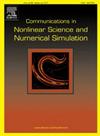Decoupled, time-marching scheme with relaxation for flow coupled with Cahn–Hilliard surfactant model
IF 3.4
2区 数学
Q1 MATHEMATICS, APPLIED
Communications in Nonlinear Science and Numerical Simulation
Pub Date : 2025-02-25
DOI:10.1016/j.cnsns.2025.108717
引用次数: 0
Abstract
We study a fluid-surfactant phase-field system under two types of fluid flow models: one consisting of two Cahn–Hilliard equations coupled with the Navier–Stokes equations, and the other consisting of two Cahn–Hilliard equations coupled with the Darcy equations. We apply the scalar auxiliary variable approach and the pressure correction method to develop a linear, fully decoupled, and second-order time-accurate numerical scheme. Additionally, a relaxation technique is introduced to improve the consistency between the discrete modified energy and the original energy. The consistency between the discrete auxiliary variable and its actual value is also improved. All variables are decoupled and can be computed sequentially. The relaxation technique is practical to implement. The unique solvability and modified energy dissipation property of the semi-discrete scheme are further proved. Numerical simulations are presented to investigate the motions of the interfaces with surfactant under shear flow or in a porous medium in two-dimensional and three-dimensional space.
求助全文
约1分钟内获得全文
求助全文
来源期刊

Communications in Nonlinear Science and Numerical Simulation
MATHEMATICS, APPLIED-MATHEMATICS, INTERDISCIPLINARY APPLICATIONS
CiteScore
6.80
自引率
7.70%
发文量
378
审稿时长
78 days
期刊介绍:
The journal publishes original research findings on experimental observation, mathematical modeling, theoretical analysis and numerical simulation, for more accurate description, better prediction or novel application, of nonlinear phenomena in science and engineering. It offers a venue for researchers to make rapid exchange of ideas and techniques in nonlinear science and complexity.
The submission of manuscripts with cross-disciplinary approaches in nonlinear science and complexity is particularly encouraged.
Topics of interest:
Nonlinear differential or delay equations, Lie group analysis and asymptotic methods, Discontinuous systems, Fractals, Fractional calculus and dynamics, Nonlinear effects in quantum mechanics, Nonlinear stochastic processes, Experimental nonlinear science, Time-series and signal analysis, Computational methods and simulations in nonlinear science and engineering, Control of dynamical systems, Synchronization, Lyapunov analysis, High-dimensional chaos and turbulence, Chaos in Hamiltonian systems, Integrable systems and solitons, Collective behavior in many-body systems, Biological physics and networks, Nonlinear mechanical systems, Complex systems and complexity.
No length limitation for contributions is set, but only concisely written manuscripts are published. Brief papers are published on the basis of Rapid Communications. Discussions of previously published papers are welcome.
 求助内容:
求助内容: 应助结果提醒方式:
应助结果提醒方式:


